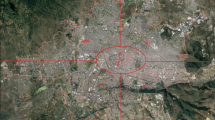Abstract
Mexican Valley is one of the Mexico’s most critical areas of water supply, the groundwater resources are overexploited at a rate of 100% or more, generating ground sinking up to 0.4 cm/year in some areas. Water shortage in this area is already at an alarmingly critical level. The situation is expected to worsen due to increasing domestic, industrial and agricultural water demands. The limited water resources, the competing users and the combination of several water sources with different qualities require the development of an adequate water distribution system. The objective of this work is to generate a water distribution model as a three-person linear game in which the users are the players, the supplied amounts from five sources are the strategies, and the total water supplies are the payoffs. Since the available water supplies are lower than the total demands from the users, a tradeoff has to be determined. The nonsymmetric Nash bargaining method is used, which requires the solution of a special optimization problem with nonlinear objective function and linear constraints. For all water distribution scenarios there is no water distribution strategy that satisfies the domestic demand with the current system. Therefore investments and further developments are needed in combination with more efficient water usage by the three sectors in the near future to secure the satisfaction of domestic users. A market driven water pricing policy also would give an incentive to the users for more efficient usage of water.
Similar content being viewed by others
References
Bekele EG, Nicklow JW (2005) Multiobjective management of ecosystem services by integrative watershed modeling and evolutionary algorithms. Water Resour Res 41:W10406. doi:10.1029/2005WR004090
Bogardi JJ, Nachtnebel HP (1994) Multi-criteria decision analysis in water resources management. UNESCO Publ. SC94/WS.14. UNESCO, Paris
Comisión Nacional del Agua (CNA) (2004) Compendio del Agua 2004. Región XIII Aguas en el Valle de Mexico y Sistema Cutzamala
Coppola E Jr, Szidarovszky F (2004) Conflict between water supply and environmental health risk: a computational neural network approach. Int Game Theor Rev 6(4):475–492
Cyert RM, DeGroot MH (1973) An analysis of cooperation and learning in a duopoly context. Am Econ Rev 63(1):24–37
Donevska K, Dodeva S, Tadeva J (2003) Urban and agricultural competition for water in the Republic of Macedonia. http://afeid.montpellier.cemagref.fr/mpl2003/Conf/Donevska.pdf
Forgo F, Szep J, Szidarovszky F (1999) Introduction to the theory of games. Kluwer, Dordrecht
Harsanyi JC, Selten R (1972) A generalized Nash solution for two-person bargaining games with incomplete information. Manage Sci 18:80–106
Hipel KW (1992) Multiple objective decision making in water resources. Water Resour Bull 28(1):3–11
Jensen PK, Hoek WVD, Konradsen F, Jehangir WA (1998) Domestic use of irrigation water in Punjab. In: 24th WEDC conference sanitation and water for All, Islamabad, Pakistan
Kapelan ZS, Savic DA, Walters GA (2005) Multiobjective design of water distribution systems under uncertainty. Water Resour Res 41:W11407
Kucukmehmetoglu M (2009) A game theoretic approach to assets the impacts of major investments on transboundary water resources: the case of the Euphrates and Tigris. Water Resour Manag 23:3069–3099
Nash J (1950) The bargaining problem. Econometrica 18:155–162
Roth EA (1979) Axiomatic models of bargaining. Springer, Berlin
Salazar R, Szidarovszky F, Coppola E, Rojano A (2007) Application of game theory for a groundwater conflict in Mexico. J Environ Manag 84:560–571
UNESCO (2006) El Agua, una responsabilidad compartida: 2. informe de las Naciones Unidas sobre el desarrollo de los recursos hídricos en el mundo. 568 pp, illus, maps; UN-WATER/WWAP/2007/02
Yang CC, Chang LC, Chen CS, Yeh MS (2009) Multi-objective planning for conjunctive use of surface and subsurface water using genetic algorithm and dynamics programming. Water Resour Manag 23:417–437
Zhang Q, Werner AD (2009) Integrated surface–subsurface modeling of Fuxianhu Lake Catchment, Southwest China. Water Resour Manag 23:2189–2204
Author information
Authors and Affiliations
Corresponding author
Rights and permissions
About this article
Cite this article
Salazar, R., Szidarovszky, F. & Rojano, A. Water Distribution Scenarios in the Mexican Valley. Water Resour Manage 24, 2959–2970 (2010). https://doi.org/10.1007/s11269-010-9589-9
Received:
Accepted:
Published:
Issue Date:
DOI: https://doi.org/10.1007/s11269-010-9589-9




